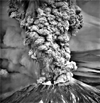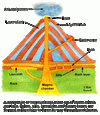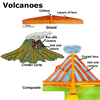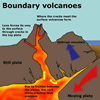 Mountains
of fire - volcanic eruptions occur wherever magma (molten rock) is able
to reach the Earth's surface. The mountain that forms as the result of
a volcanic eruption is called a volcano.
Mountains
of fire - volcanic eruptions occur wherever magma (molten rock) is able
to reach the Earth's surface. The mountain that forms as the result of
a volcanic eruption is called a volcano.
There are three types of volcanoes each associated with a different type of volcanic eruption. This topic investigates the characteristics of volcanoes, volcanic eruptions and the types of volcanoes.
Characteristics of volcanoes

The process of magma breaking through the surface is known as an eruption and the hole through which the eruption occurs is called a vent. As a volcano builds, it forms a bowl shaped blast area or crater. A crater may have one or more vents and if it is larger than 1.5 km across it is known as a caldera.
Active, dormant or extinct?
Volcanoes are referred to as active, dormant or extinct depending
on their present and past behaviour. A volcano that has erupted in the
last 100 years is considered to be active. Dormant volcanoes are those which
have not erupted in the last 100 to 1000 years, while those which have
not been active for over 1000 years are said to be extinct.
Volcanic eruptions
Volcanic eruptions can range from quiet streams of lava to violent explosions
of hot gas, rock, steam and ash.
Features of eruptions are:
- Lava flows - molten rock flowing from
a vent pours down the slope of the volcano, moving at speeds of up to
40 km/hr. As the lava flows away from the vent it cools and hardens,
forming new igneous rock.
- Ash - formed during explosive eruptions,
fine-grained ash can be shot many kilometres into the air and settle
over large surrounding areas.
- Bombs - molten lava lumps hurled skyward cool and harden in flight, landing as solid rocks. To be considered a volcanic bomb, the rock must be at least 6cm across, but they have been recorded as large as cars.
Pictures of ash, lava and bombs
Types of volcanoes
 The
three types of volcanoes are named from their shape and structure. Each
forms in a different way from a variety of volcanic materials.
The
three types of volcanoes are named from their shape and structure. Each
forms in a different way from a variety of volcanic materials.
- Shield volcanoes form from runny lava
which flows easily, producing a low shield-like structure around a vent.
Many volcanic islands are the tops of large undersea shield volcanoes.
- Cinder Cone volcanoes form when viscous
lava, ash and rock build up around a vent. These volcanoes typically
have steep upper slopes with gentler sloping bases.
- Composite volcanoes form when alternating layers of ash and lava are laid down from a vent. These volcanoes are similar in appearance to Cinder Cone volcanoes.
Where do volcanoes form?
 There
are no active volcanoes in mainland Australia, but there are plenty of
extinct ones. Big Ben on the Australian territory of Heard Island and
others in the Macdonald Group Islands are volcanoes that are considered
active. Volcanoes form in three areas; along the edges of tectonic plates,
over oceanic ridges and on volcanic hot spots. Extinct volcanoes can be found
in all states, but the ones in Queensland and Victoria are the most typical
of volcano shapes.
There
are no active volcanoes in mainland Australia, but there are plenty of
extinct ones. Big Ben on the Australian territory of Heard Island and
others in the Macdonald Group Islands are volcanoes that are considered
active. Volcanoes form in three areas; along the edges of tectonic plates,
over oceanic ridges and on volcanic hot spots. Extinct volcanoes can be found
in all states, but the ones in Queensland and Victoria are the most typical
of volcano shapes.
Where two tectonic plates meet and collide, the older and denser crust subducts (slides under) the younger, more buoyant crust. This creates weak spots where magma can come to the surface. The volcanoes forming the "Ring of Fire" which encircles the Pacific Ocean along the American and Asian coasts are formed along the boundary of the Pacific plate.
The second large group of volcanoes has formed along the mid-atlantic and mid-pacific ridges. Volcanoes on these ridges are created as new crust is formed where the tectonic plates are moving apart.
The third area of volcanic activity is over hot spots in the Earth's crust. These locations deep under the crust are usually far from any tectonic plate boundaries and are parts of the Earth's mantle that are particularly hot. Periodically, the crust above a hot spot cracks and a volcano forms. As the crust moves over a hot spot, a chain of volcanoes can form. This can occur over thousands of years. The Hawaiian islands have formed over a hot spot and it is thought that many of Australia's younger volcanoes have formed over hot spots.
Iceland has formed over a hot spot that happens to be in the mid-atlantic ridge, effectively doubling the lava produced. It is growing larger as new material is brought to the surface by its volcanoes.
One theory states that Queensland's Glasshouse mountains and a chain of volcanoes in New South Wales formed over a hot spot and predicts the next place an eruption could occur is in Tasmania!

|
Hot spot forming a chain of volcanoes. |
| Copyright owned by the State of Victoria (Department of Education and Early Childhood Development). Used with Permission. |